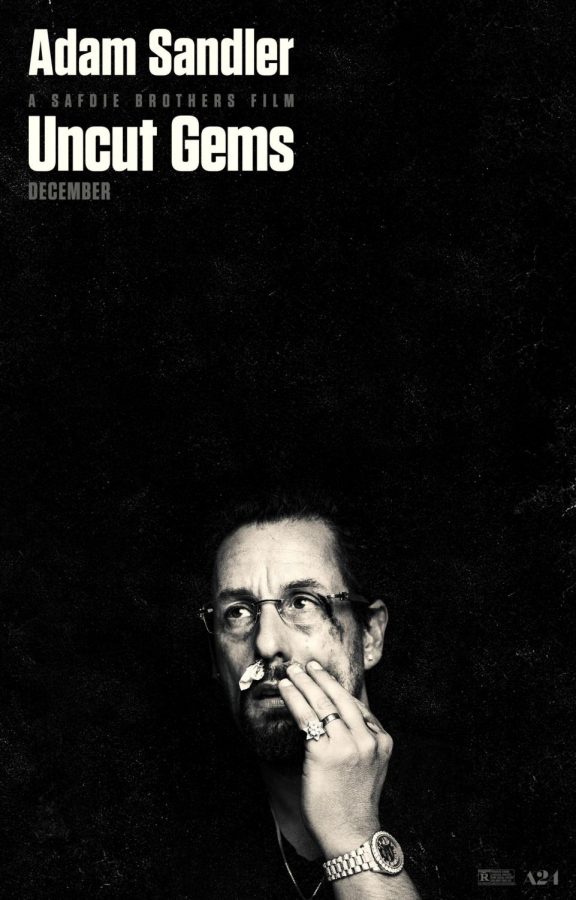Review: “Uncut Gems” glitters on the wild side
January 2, 2020
The Safdie brothers’ latest “Uncut Gems” is a relentlessly propulsive exercise in anxiety-inducing cinema, thanks to Adam Sandler’s electrifying performance.
The film centers on Sandler’s Howard Ratner, a New York City jeweler and compulsive gambler. Already indebted to loan sharks, Ratner engages in increasingly risky bets, especially involving his latest celebrity customer, Boston Celtics star Kevin Garnett, played by himself. Ratner should have been able to establish a clean slate off debt as the Celtics enjoy a series of victories, but the manic excitement of his hustle only serves to drive him further into a time bomb of addiction that may not end well for him.
Sandler has perfected the craft of annoying audiences through his prior comedies. In “Uncut Gems”, the Safdie brothers use Sandler’s talents to bring out an equally annoying character in Ratner to great effect. There is an entertaining quality in seeing the Jewish jeweler in his chaotic days at work, which include keeping his wayward partner, played by a marvelous Lakeith Stanfield, in line. This is coupled with the tough task of balancing his family life, led by Idina Menzel as his aggravated wife and his young mistress Julia, played by Julia Fox. Howard Ratner might be an irritating character, but at the center of it all, the audience ends up worrying about what will happen to him next as he thrives in the excesses of his world.
Written by the Safdie brothers and frequent collaborator Ronald Bronstein, the crux of the film lies with the titular opal, which is shown to be extracted from the bowels of an Ethiopian mine. Think about the dual symbolism of the opal. It can mean good fortune, which Ratner comes into but is constantly yanked off of him through Garnett’s relentless inquiries, which is sincere compared to Ratner’s unfeeling “all in the game” mentality. In one scene, the basketball player states his concern for the poor African miners as he uses the opal for good luck in his games. On the other hand, the “uncut gems” can also be interpreted as mystical items that could drive men to insanity with their hypnotic pull, a trope that dates back to the legend of El Dorado.
The Safdie brothers take their cue from their previous films such as “Heaven Knows What” and “Good Time” in establishing a portrait of New York City as a place which, while certainly caught up in the gentrification of modern times, is still a hotbed of street-level hustlers who do not always forget gambling debts. The gorgeous cinematography from Darius Khondji is worth a mention, as it brings to the forefront the dissonant juxtaposition between the glamour and the hustle of the city.
Simply speaking, “Uncut Gems” grabs the viewer by the balls and never lets go. It runs at the pace of a high speed train with faulty brakes, which is only compounded by its focal point in Howard. A lot of stuff happens in the film that might be hard to keep track of. The Safdie brothers are not interested in a night of relaxation; instead, they serve to provide their viewers with a sense of anxiety that pushes cinematic form to its limit.
Like their character Howard Ratner — as well as their filmmaking contemporaries like Gaspar Noe — the Safdie brothers thrive on chaos.
And that’s just the twisted, brilliant beauty of the film. It aims to unsettle the viewer, exposing the unpleasant dark side of going for the big score. Howard sinks so deep into the delusion of this particular goal that he doesn’t notice the glass floor showing cracks of reality. As it gives in, so is his momentary bliss in self destruction. “Uncut Gems” is visually immersive. At the same time, it makes its impression felt through its exhilarating command of Ratner’s tight ship.









